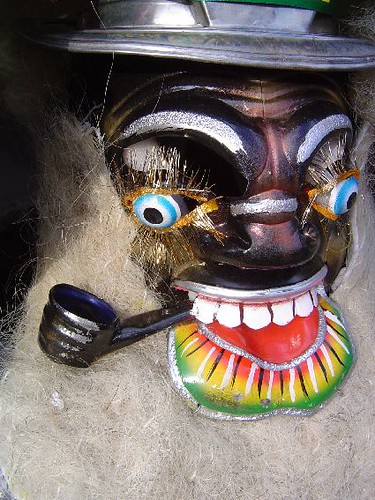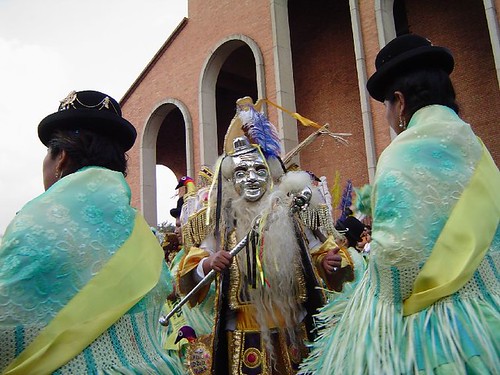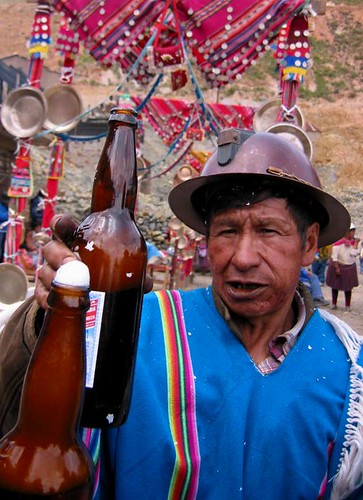The devil you know
Late last month, I came across a BBC online photo essay that immediately brought back memories of my undergraduate study of Anthropology. Considering that study was some 10 years and more ago, I think that was pretty remarkable.
The photos were of La Diabldada Festival in Oruro, Bolivia, and feature the gloriously detailed and colourful devil masks and costumes of the festival and its parade. The festival is a strong expression of the pre-Columbian Andean traditions, mythology and ritual that remain strong features of Bolivia's Andean people.
One of the first things I did was explore whether the massive flickr community also had photographs of La Diablada and the Bolivian Andean community who celebrate the festival. You wouldn't begin to guess the jackpot I hit. I also set it as a task of 'using my degree', something I periodically give cause to obsess about (considering I put a lot of energy, time and resources into completing it!
I was amazed how many photos were published on the Creative Commons license. All the photos here are Creative Commons-licensed photos found on Flickr.
When I saw the photos and remembered my second year Anthropology studies, I wondered how much things may have changed in the 17 years since I studied anthropology at university. I was particularly interested in how much the increased accessibility in travel, and the way the internet has allowed an explosion in the sharing of stories, photos, experiences and knowledge of things – including festivals, traditions and rituals – in places we may have once considered distant, unreachable and the domain of the brave few who ventured to explore them, or the isolated people who live these as daily realities, has affected how we 'know' the world around us.
 'Máscara de Morenada' by Cltn - masked performer at what appears to be a festival by Bolivians in Sao Paulo, Brazil
'Máscara de Morenada' by Cltn - masked performer at what appears to be a festival by Bolivians in Sao Paulo, BrazilThe internet has brought together online the experiences and stories of people across the world, and their documentation and publication under creative commons licenses.
Not withstanding the concerns with the accuracy of much of this information, this development allows other writers, bloggers, media makers and other armchair sticky-beaks like me – and more importantly students and academics – to use them with the freedom that creative commons licenses offer. How much can the internet, social networking, blogging and creative commons licensed content creation and sharing improve teaching in universities? How much is this also unreflexive voyeurism? Perhaps that's the topic for another post.
What I do know is that I certainly did not get to enjoy the colour and vibrancy of these images to assist me in understanding what we were learning in anthropology. I wish I had access to these images then.
The Andean people in these parts of Bolivia have historically been the working backbone of Bolivia's now declining tin mining industry. The ethnogography, by Michael Taussig, we studied in second year anthropology examined how the devil featured in Latin American working class and peasant communities and expressed their experience of the brutality and exploitation of Latin American capitalism. According to wikipedia, in The Devil and Commodity Fetishism in South America:
Taussig … argues that through the devil, peasants express their recognition that capitalism is based on the magic belief that capital is productive, when in fact capitalism breeds poverty, disease, and death."
As developing countries, and mining communities in particular, suffer in the agonies and conflagrations of another global economic crisis, and communities are threatened by the flight or collapse of capital or falling commodity prices, I also wonder to what extent the internet can contribute to bearing witness to their struggles and document their traditions.
 El tio de la mina, Oruro by germeister - shrine to the devil of the mine, El Tio. Such expressions were a central focus of enthonographies of the 1980s.
El tio de la mina, Oruro by germeister - shrine to the devil of the mine, El Tio. Such expressions were a central focus of enthonographies of the 1980s.Or whether the internet will just become another type of museum. Not that there's much wrong with museums (that are reflexive of their work and role in cultures). I guess the opportunities the internet offers us is more ways to engage with the content online, and with other people creating and sharing this content.
By the way, did I tell you how much I really enjoyed Barista's excellent, highly informed and exploration of the Chinese demon-catching god? (It is beautifully illustrated by illustrations now in the public domain.) Or Sophie Cunningham's amazing photographs of the Balinese festival to banish bad demons? How remiss of me.
Labels: blogging, culture, internet, myth and ritual, photos
















2 Comments:
Spam begone. Spammers begone!
the first pic is about a bear by the way
Post a Comment
<< Home